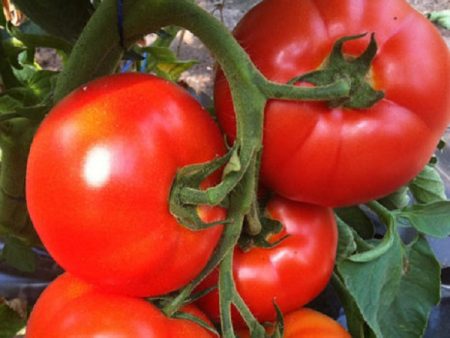
Dutch tomato hybrids are among the favorites of many gardeners, since they, with proper care, give very good results. It is productivity that is famous for the hybrid from Enza Zaden - Buran F1, which is grown both by private traders and many vegetable farms.
Content
Hybrid Description
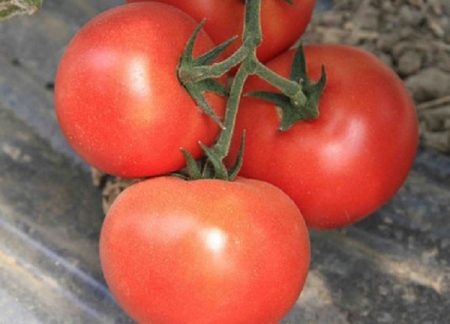
Tomato Buran F1 is included in the State Register, it is recommended for cultivation in all regions, in areas of risky farming - in film shelters.
The plant is tall and powerful, beautiful, forming a large number of fruits weighing up to 200-220 grams. In the southern regions, up to 30 kg of fruit per square meter is removed from open-bed ridges, in greenhouses of the middle strip and the North-West, due to the climate, the indicators will be slightly lower, then they will also be impressive - up to 12 kg per square meter.
The hybrid is resistant to many diseases, fruitful, and therefore came to the "court" of many farmers and ordinary gardeners.
Main characteristics
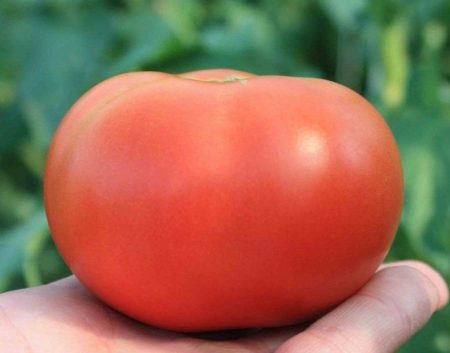
A hybrid with the original “winter” name Buran F1 belongs to the category of tall tomatoes. This is an indeterminate plant, tall, up to 180-210 cm. In terms of ripening - mid-season hybrid, the first fruits can be harvested after 110 days.
Mandatory bushes require the formation, removal of stepchildren, as well as the presence of backwater. Buran shows good results in greenhouses when grown using the trellis method. The bush has large, dark green leaves, inflorescences are simple. Fruits first have a pale green color, with full ripening, the skin and flesh become dark red. The skin is dense, with gloss. The fruit mass is up to 230 grams, on average - 180 grams. All the tomatoes in the brushes are smooth and beautiful.
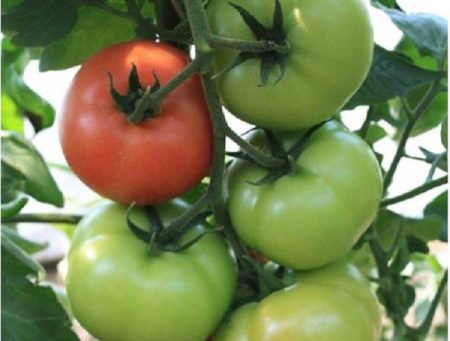
The pulp is juicy, usually located up to 6 chambers. The taste is excellent, mainly this hybrid is for fresh consumption and salads. The fruits of the hybrid are suitable for juice, lecho, pasta, a variety of sauces. Burana products have a rich red color and look very appetizing.
Hybrid Advantages
Buran F1 is praised by many, appreciating the tomato for the following qualities:
- unpretentiousness;
- high productivity (but it is necessary to provide good nutrition to plants);
- mid-season;
- good taste;
- large-fruited;
- suitability for transportation;
- good fruit setting;
- Attractive appearance of tomatoes.
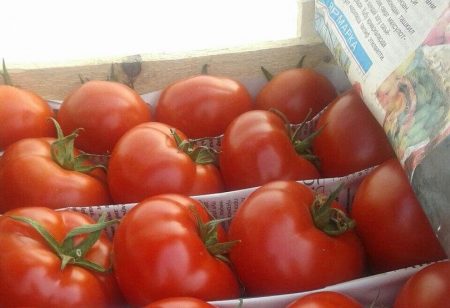
Tomato Buran is one of the best hybrids for various tomato products. In addition, this hybrid is resistant to a number of traditional tomato diseases:
- cladosporiosis;
- VTM;
- Fusarium
For tomatoes grown in greenhouses, this is a very important quality. It is difficult to get a high tomato crop in the harsh climatic conditions of the Urals, Siberia, northern regions, especially if the summer is cold and rainy. But tomato Buran gives very good results, the main thing is not to forget about providing plants with proper care.
The disadvantages of the hybrid Buran F1
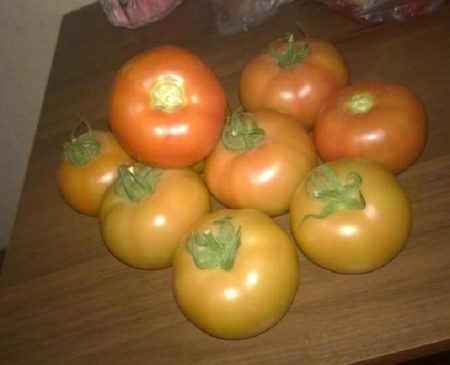
Speaking about the yield of such tomatoes, breeders always pay special attention to agricultural technology. Hybrids give results only in the presence of good top dressing, regular watering, weeding.
Also, tall Buran needs to be formed (usually plants “lead” into two stems), timely to remove all stepsons.Another “minus”: if a tomato is to your liking, you will need to purchase seed material in advance every year. It is not recommended to take your own seeds from F1 hybrids, since such tomatoes do not subsequently retain the desired properties and do not get the desired results.
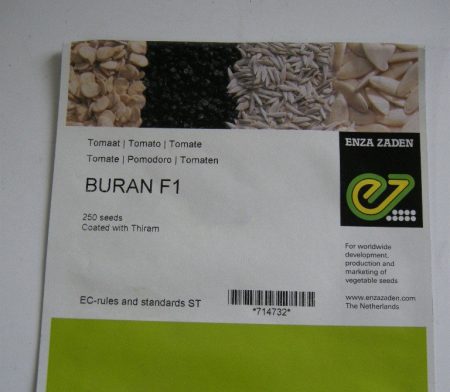
Otherwise, there are no shortcomings, and the “Dutchman” deserves attention.
Buran F1 Hybrid Growth Reviews
Sofia, Kirov
I bought tomato Buran, I always try new varieties and hybrids every year. I didn’t like it, because the fruits began to be tied up late, although maybe our climate did not fit him. I took tomatoes all green, ripened well at home in a box. The taste is ordinary, there is sourness. In the brush, the fruits were all even, about 150 grams in weight.
Igor, Leningrad region
Buran bought on the occasion, just in the store the seller praised this hybrid very much. I sowed seedlings late, at first I didn’t want to sow at all, I forgot about this tomato. But he quickly caught up with the one that was sown two weeks earlier, and then it became quite suitable. Planted in early June in the greenhouse, a total of 4 bushes grew. Harvest good, very resistant tomato to late blight. At the end of July, I had quite a lot of tomatoes in the greenhouse, and prevention did not help, and these bushes stood green. Tomatoes are delicious, we all went to salad preparations.
Features agricultural technology hybrid F1 Buran
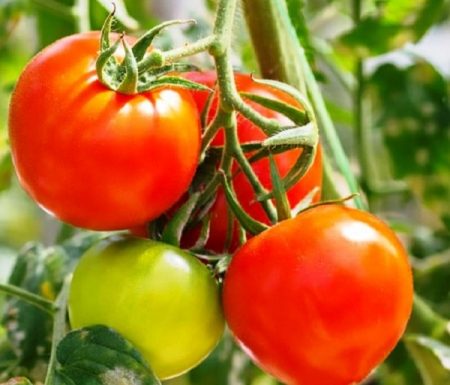
First, you will need to grow tomato seedlings, for which they prepare not only seeds, but also boxes, cups for seedlings, nutritious soil.
Growing seedlings
Inexperienced gardeners overlook the fact that a good harvest will only be possible if the seedlings are properly grown and healthy. For this:
- Determined with the timing of sowing tomatoes (usually for hybrids such ripening dates as Buran - this is March).
- Steamed the ground for seedlings, carry out the disinfection of containers where tomatoes will be grown.
- For hybrids, seed treatment is usually not required. The manufacturer reports this in the information on the seed bag. Therefore, on the appointed day, seeds are sown in the ground.
Be sure to observe the temperature regime: +25 ºC ... 27ºC - during the period of seed germination, +22 ºC ... 25ºC during the period of growing seedlings. It is advisable to provide seedlings with a stable temperature, without differences.
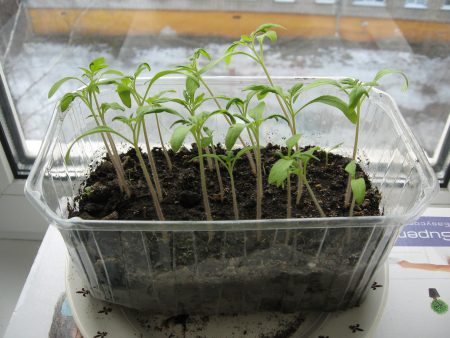
After the plants have two true leaves, a transplant is required. If tomatoes are initially grown in separate containers of sufficient volume, then only the soil is added to the plants. When sowing seeds in common boxes or containers, diving in separate cups is mandatory.
All fertilizing seedlings is carried out only after a dive, after waiting at least a week. Time is given so that the plants can take root and go on growing further. As fertilizers at home, it is best to use ready-made compounds (KEMIRA, AGRICOLA No. 3 - composition for tomatoes, peppers, eggplant). Complex fertilizers, such as nitrofoski, are also suitable.
Feeding is recommended along with watering. When growing tomato seedlings, it is very important to avoid waterlogging the soil, as this threatens the appearance of various diseases. Among them - a dangerous "black leg", which manifests itself in seedlings if the irrigation schedule and air temperature are not observed. Proper care can protect you from adversity; you can also sprinkle earth around plants with calcined river sand or ash.
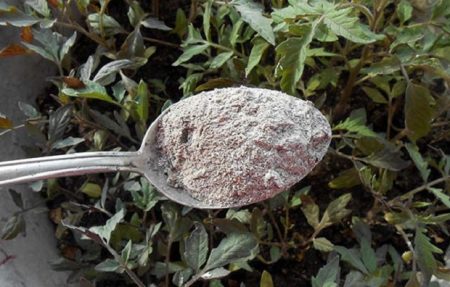
After about two weeks, the tomatoes begin to harden, taking them out onto the street (in warm weather) or onto the balcony.In the first days, plants will have enough 15-30 minutes of fresh air, then the duration can be increased to several hours. The procedure is very useful, allowing in the future to avoid stress for plants during the transplant period.
Tomato care in the greenhouse
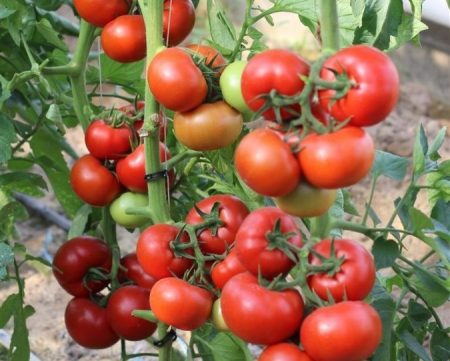
The timing of planting plants in the greenhouse depends on many factors:
- condition of tomatoes;
- air temperature, soil;
- climatic features of the region.
The Buran hybrid is quite resistant to many weather troubles, but it is still necessary to follow the rules of agricultural technology. Tomatoes are planted when the soil at a depth of about 10 cm warms up to + 14ºC ... 16ºC. In greenhouses, the ridges can be additionally covered with a film so that the soil heats up faster. After planting tomatoes, it is also advisable to cover them with lutrasil, agril, in order to protect from unnecessary stress, possible temperature changes.
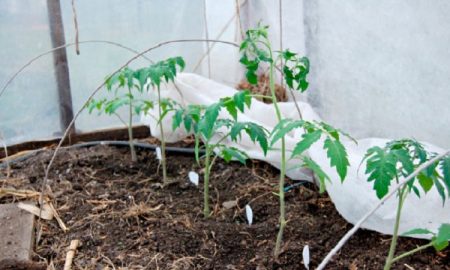
Full care includes:
- watering;
- mandatory loosening (many gardeners without experience forget about this technique);
- fertilizer application;
- weeding.
When growing this hybrid, one can not do without plant formation, pinching. It is recommended that you immediately equip the greenhouse with trellis supports. If the tomatoes will have individual supports, then they prepare stakes (rods), cotton ribbons (it is better to use them to tie them up, not the ropes).
Tomatoes are watered regularly, given the weather conditions and the microclimate in the greenhouse. These plants do not like high humidity, they do not tolerate dry air (especially during flowering), so you need to observe the amount of watering, be sure to ventilate the greenhouse.
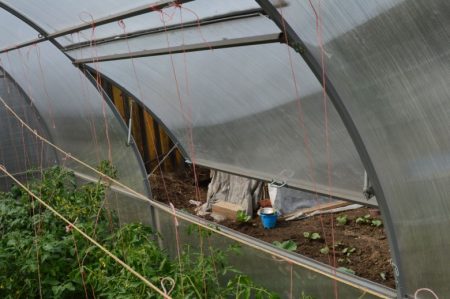
An approximate schedule of irrigation is twice every 7-8 days. During flowering and the beginning of fruiting, water volumes increase, in August, when mass ripening of fruits begins, watering is gradually reduced, and then stopped.
After watering, the soil is carefully loosened, trying not to touch the roots of the plants. Mulching the soil will replace loosening, thereby saving time. Mulch - humus, peat, sawdust or hay, provides the soil with protection against drying out, excessive moisture. There are few weeds on such ridges, and this also greatly simplifies the care of tomatoes.
During the cultivation of tomatoes, fertilizing is carried out, while it must be taken into account that the plants in the greenhouse will have a higher need for nutrition than the tomatoes growing in the exhaust gas (open ground). It is especially important to provide tomatoes with potassium, calcium, phosphorus, since in conditions of increased greenhouse humidity and insufficient light, these elements are absorbed more intensely.
In the first feeding, usually nitrogen prevails, which plants need to build green mass, in subsequent feeding, priority is given to phosphorus and potassium fertilizers.
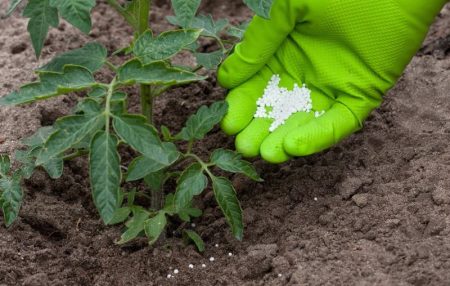
From organics, mullein or droppings of birds that are bred with water, strictly observing the proportions (1:10 and 1:20), are suitable. When the first fruits appear, it is good to feed the tomatoes with “green” organics, which are prepared by insisting on various herbs on the water.
To do this, put chopped nettles, a wandering comfrey, a dandelion in a large container (tank, barrel), fill everything with water and let it brew for 5-7 days. The infusion on top is closed with a lid or film. Once the composition is fermented, it must be mixed. After a week, the finished fertilizer can be used for tomatoes. It is diluted with water: a liter of infusion on a bucket of water and gently pour tomatoes under the root.
Of the finished preparations for top dressing apply:
- Fitosporin-M (the composition also serves as a means of prevention from powdery mildew, root rot);
- Fertika Crystal;
- Agricola
- Kemira
- Aquarin.
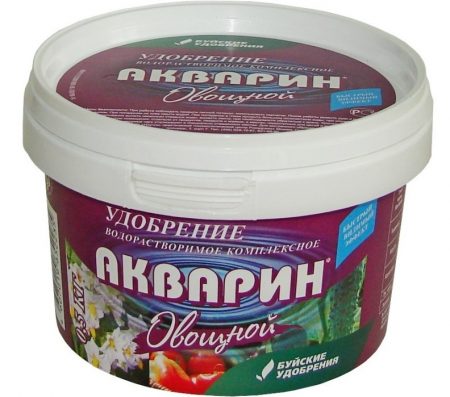
Purchased formulations have instructions, so all top dressing is carried out following the indicated recommendations.
What compounds can be used for spraying tomatoes?
- During flowering - infusion of ash (do not forget to filter the infusion).
- Also, during flowering, treatment of plants with urea is shown (diluted with water: 50 grams per bucket of water).
- Once a month, spraying with boric acid diluted in water is used.
It is advisable to alternate the types of top dressing: organics with mineral fertilizers, foliar spraying with fertilizers under the root.
Buran is usually formed in two stems, although it is possible to leave only one “trunk” or increase the number to three to four. If a larger quantity is left, then two bushes are planted per square meter so that then the branches of the plants do not block each other.
Also, all stepchildren are removed from tomatoes in a timely manner, preventing the "overgrowing" of bushes to the extent of the jungle. Harvesting tomatoes is carried out approximately 110 days, but at this point the fruits are still green. Tomatoes are removed in a state of technical ripeness, dosing them at home.




 Low-growing tomatoes, without pinching: 5 of the most delicious varieties
Low-growing tomatoes, without pinching: 5 of the most delicious varieties Why tomato seedlings grow poorly
Why tomato seedlings grow poorly We grow a tomato in a shell
We grow a tomato in a shell Growing tomatoes without watering according to the method of Kazarin
Growing tomatoes without watering according to the method of Kazarin